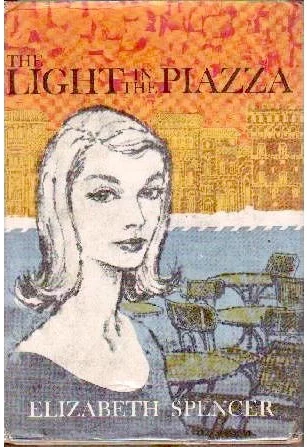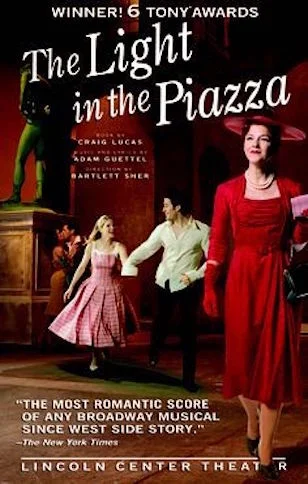There are supposedly more than 20 green-lighted musical projects preparing for the camera in Hollywood. I hope one of them is The Light in the Piazza.
In Elizabeth Spencer’s novella, an American lady of the 1950s touring Florence with her daughter sets two families’ lives as well as Italian and US cultures on a collision course. When Margaret makes the decision to allow—actually to engineer—a marriage for her daughter Clara…beautiful Clara, “with the mental age of a ten year old”…the mother surely does so for Clara. Perhaps Margaret also does it for herself. Are the two cultures akin if not alike, and love is all …as a wife in a language she does not speak, will Clara be able to forge a life she understands …what other opportunity for happiness would ever come Clara’s way again? ...who has a happy life in the US—and who doesn’t have a happy life in Tuscany? ...and what is happy anyway? The slender volume poses questions in a story as delicate as that, and creates a work of Art just as monumental.
Two years after The Light in The Piazza’s publication, it was made into a movie.
The 1962 screen adaptation was soundly trashed—everything was off—Julius Epstein’s screenplay (Julius and his brother scripted Casablanca) was a love story and in order to make it a love story for the screen, the lush movie travelogue glazed over the central issue in the novel. The movie obliterated Spencer’s questions, prompting a US critic to conclude “despite the sweet performance of Miss de Havilland, the pretty color pictures and a highly romantic musical score by Mario Nascimbene…Arthur Freed, the producer, and Guy Green, the director, did in whatever chance there was to make something of Elizabeth Spencer's little story when they glamorized the girl.” A critic on the other side of the Atlantic was as unimpressed. “Elizabeth Spencer's baroque, almost Jamesian novel of New World corruption versus Old World integrity is brought to the screen in the form of a 'grand tour' of North Italy. In the course of this, Olivia de Havilland tries to marry off her mentally retarded daughter to a wealthy Italian...a terrible film.”
Yet somehow there is still wiggle room for me to champion the movie. The film is just plain beautiful. And, just between us, I go for the Baroque…even the Jamesian…and Piazza had both literary chops when I first read Spencer’s novella in school. I immediately felt the prose was absolutely lyrical. Operatic. Lots of novels and DVDs and bookcases since then, and this tiny volume has made all those moves with me. Regardless the critical lambasting of the movie adaptation, I added the Light in the Piazza DVD to my shelves.
In 2005 I saw the musical adaptation at Lincoln Center. No curtain…no overture…unseen orchestra…heard melodies…Victoria Clarke in pink as the 1950s mother with her guide book; Kelli O’Hara, the damaged ingénue in pale blue; Matthew Morrison in billowy white, her swarthy Italian suitor; the impressionistic Piazza with a verdigris papier-mâché statue coming to life on the stage as Clara’s single note of reverie morphs into a song…Clara’s straw sun hat flies above us on string as a cast of tourists and Florentines at work and on passeggiata becomes a musical story. Spencer’s lilting fable with a score by Adam Guettel worthy of his pedigree as Maestro Richard Rodgers’ grandson.
The artificiality of the story as a Broadway musical ironically gives traction to the story’s themes. The complications mesh because as a stage musical, the production is…lyrical….operatic. In Donizetti’s "Mad Scene" aria, "Il dolce suono... Spargi d'amaro pianto", no one questions Lucia di Lammermoor’s breakdown awash in the coloratura soprano’s gorgeous musical breakthrough. Beauty becomes the language of reality. I bought Craig Lucas’ play’s text; I bought Guettel’s original cast CD, and I purchased the souvenir program, now all treasured along with the DVD movie adaptation and Spencer’s lithe novella in my bookcase.


